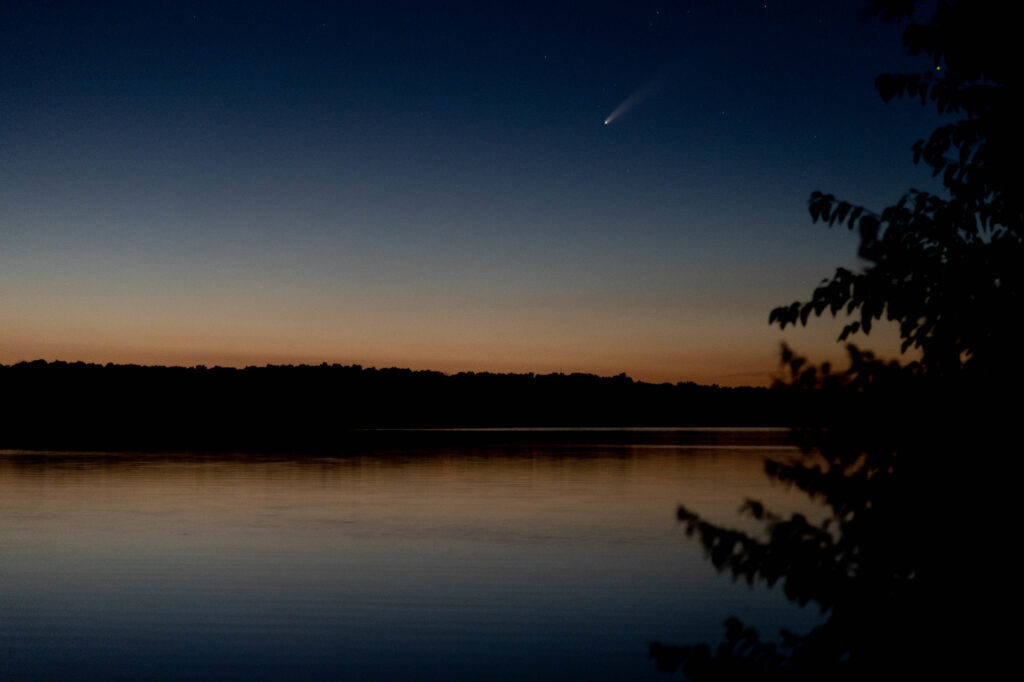Let the soft strobing light of fireflies show you to your seats. When the sun sets, the nighttime symphony begins.
As all string sections must, each musician draws their bow slowly across their instrument creating different thrumming tones. Together, the rising volume of cricket’s music reaches a crescendo when the sun drops below the horizon. How does the humble cricket produce their concerto?
A cricket’s chirp originates from their wings. Instead of legs sawing together like grasshoppers, a cricket will scrape a specialized part of one wing across wrinkles under the other wing. This process, called “stridulation,” is much like rubbing your thumb over the teeth of a comb.
This vibrato has different volumes. One reason is that all species have unique chirps. A common field cricket can chirp at 100 decibels, close to that of a referee whistle. Others are at a volume similar to a car horn, making car alarms which go off in the night confusing to females searching for mates.
Another reason the volume varies is temperature. Scientist Amos Dolber first noted the relationship in an article published in 1897 by The American Naturalist. Now called Dolber’s Law, it has been verified that you can calculate the ambient temperature by counting cricket pulses, give or take 1-2 degrees. The formula is the number of chirps over 14 seconds plus 40. For example, if you hear 35 pulses over 14 seconds, it is about 75 degrees out.
As the stars reveal themselves to the night sky, lively notes not unlike a flute shimmer through the air. Songbirds of the night have awoken. But is there one among them whose common tune can be heard above the rest?
Whippoorwills have one of the most easily identifiable songs in the eastern United States. Their name is onomatopoeic, meaning it mimics the sound of the call–whip-poor-will. The song is especially notable because it is incessant. One observer with the Audubon Society counted 1,088 calls without a break in a single night.
This loud repetitive song is so well known in rural areas, it’s even featured literature. In a short story by quintessential American author William Faulkner, the bird was used as a plot device to signal dawn arrived because the whippoorwill finally stopped singing.
The eastern whippoorwill is strictly nocturnal. Moths, one of their primary food sources, are easy to spot by moonlight. Whippoorwills, for the most part, lay their eggs on a lunar cycle with hatch averaging 10 days before a full moon. This maximizes the amount of food adults can catch for hungry hatchlings.
Above the silhouette of trees, the moon has crested. Low and resonant like a french horn, the mournful call of a solitary owl vibrates through the forest. Does this woodland brass section have more than one instrument?
Though owls are fairly common, their nighttime habits make them mysterious. Pop culture defines their call as a “hoot” but yelps, whistles, barks, beak snaps, screeches, growls and shrieks are part of their vocabulary.
A low pitched hoot is a territorial call. The great horned owl’s well known “hoo-hoo-hoo-oooo” or the smaller barred owl’s “who cooks for you?” can reverberate for miles.
A loud shriek, described like a woman screaming, signals an owl feeling threatened. That could turn into a bark or growl if the predator or threat still needs to be deterred.
The Owl Research Institute has recorded duets in some courtship rituals. The female begins a song and the male joins in with complementary sounds. Owls make their first sounds while still in the egg, making the end of the breeding season noisy with the barks and shrieks of hatchlings. It can take up to a year before chicks vocalize like their parents.
The eastern horizon is brightening with graduating shades of golden light. Yet the chimes and burbles of frogs pulse on, resounding through the air like gongs and bells. How can these amphibians become solo artists when surrounded by a powerful percussion section?
The clicks, quacks, whistles, trills, ribbits and croaks of frogs and toads can be deafening. Starting in the spring and through summer, frogs spend the night in raucous courtship rituals. Male frogs make complex calls that are finely tuned to get the attention of females of the same species. They can be heard over a kilometer away and even underwater.
Many frogs do not typically live in the area they use to find mates and breed. That is why during the breeding season some wetlands, ponds and lakes may seem noisier than in fall and winter. Thousands of frogs gather in a single place only for the days or weeks their species requires for courtship.
When there are a tremendous number of frogs in a relatively small body of water vying for attention, male frogs may create a chorus. Each frog sings in succession, allowing all of them to take a turn in the spotlight.
Night is over. Each morning the trees give a standing ovation for the nighttime symphony, their broad leaves offering applause as a gentle morning breeze blows through them.
Kelley V Phillips is the Outreach Coordinator for Red-tail Land Conservancy. Her work in community engagement inspires excitement and wonder in nature through education and tangible experiences.
Photo © 2020 Kyle Allen Johnson




